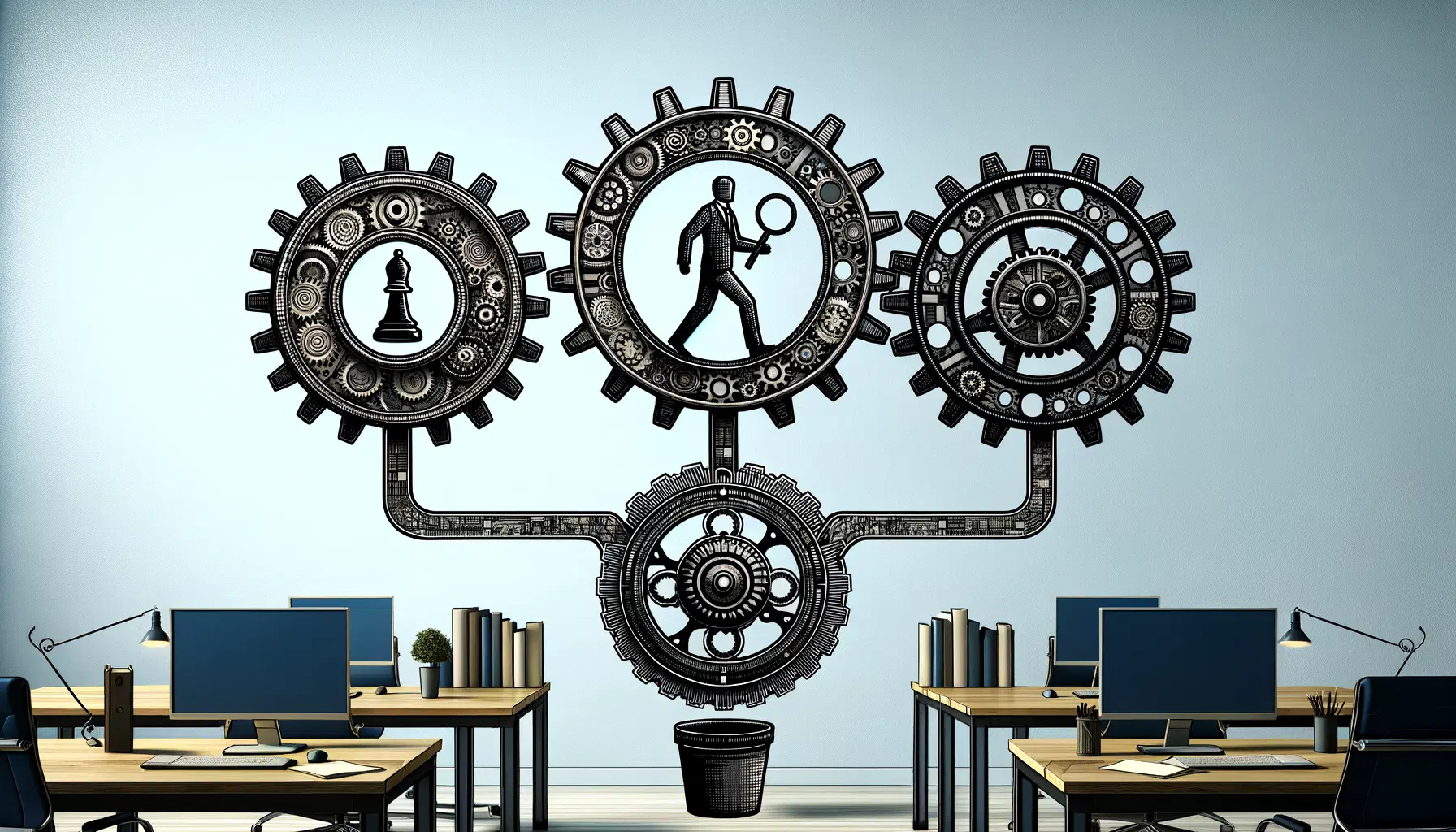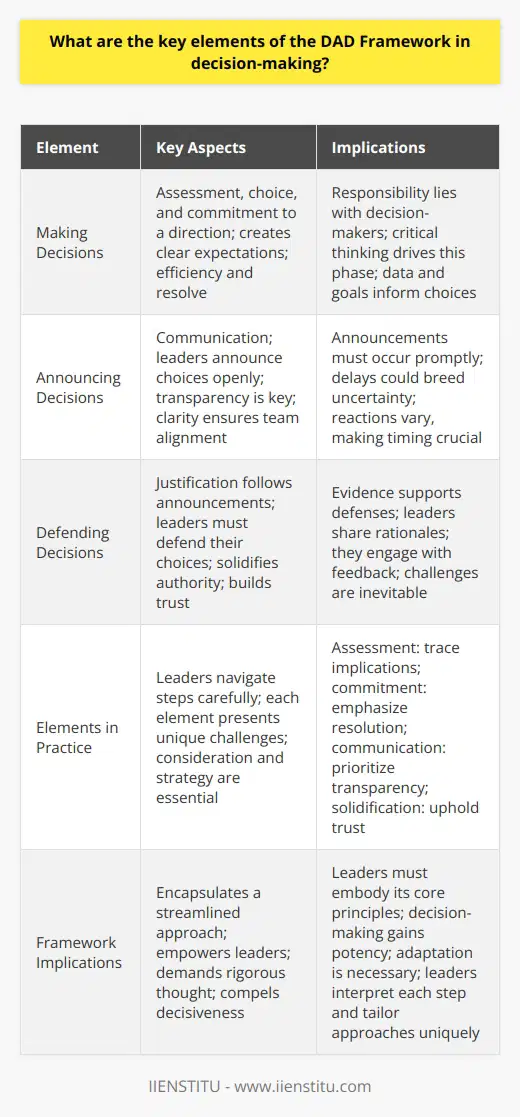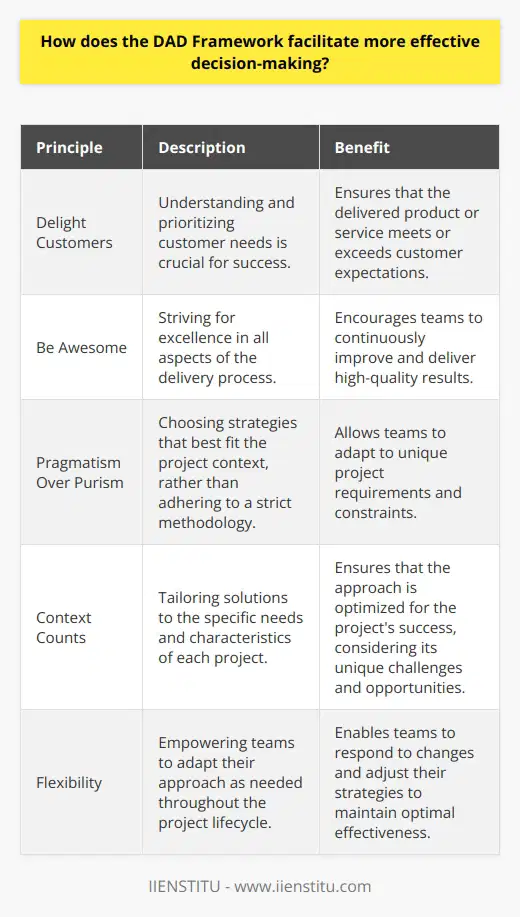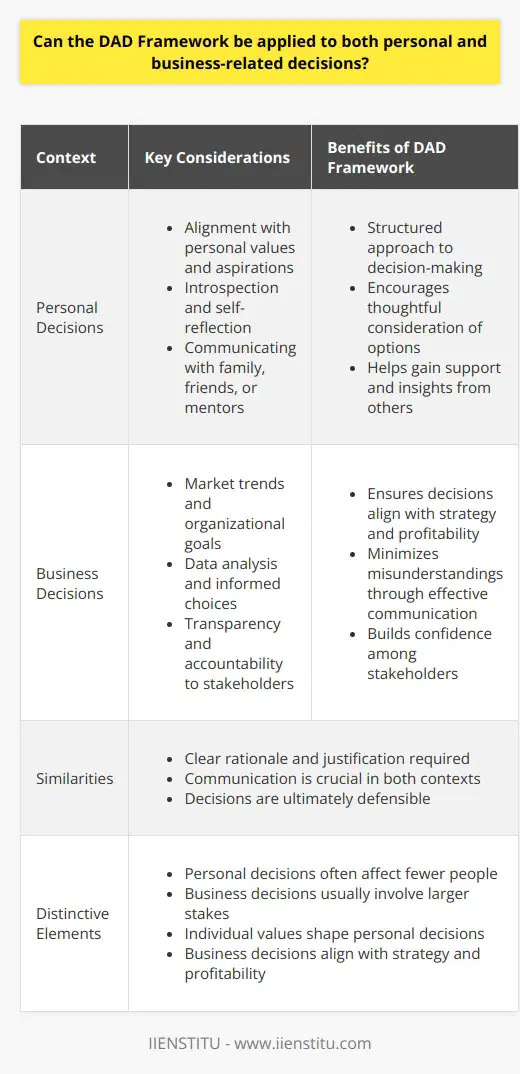
Imagine standing at a crossroads, where every turn leads to a myriad of possibilities. Decision-making, in both our personal and professional lives, often feels just like that—navigating through an intricate maze with no clear endpoint in sight. Throughout my career, I've encountered countless situations where making the right choice wasn't just about gut feeling; it was about having a solid framework to rely on. That's where the Decision, Action, Dialogue (DAD) Framework comes into play, serving as a compass in the vast ocean of possibilities.
Unveiling the DAD Framework: A Journey Towards Mastery
I recall a time early in my managerial role when I was tasked with steering a project that could make or break our department's reputation. The stakes were high, and the pressure was palpable. It was then that I stumbled upon the DAD Framework, a model that elegantly intertwines critical thinking, swift execution, and dynamic communication. This framework didn't just help me make decisions; it transformed the way I approached challenges altogether.
Discovery: Unearthing the Hidden Gems
The first pillar of the framework, Discovery, is all about gathering information—think of it as collecting the puzzle pieces before you start assembling them. In my situation, this meant diving deep into market research, consulting with industry experts, and understanding the historical data that could influence our project's outcome.
Techniques for Effective Discovery:
1- Ask Open-Ended Questions: Engaging with team members and stakeholders by asking questions that encourage detailed responses.
2- Leverage Multiple Sources: Utilizing books, academic journals, and field studies to gather diverse perspectives.
3- Empathy Mapping: Understanding the needs and concerns of those affected by the decision.
During this phase, I couldn't help but feel like a detective piecing together clues. The more information I gathered, the clearer the path ahead became. It's a bit like those 5 amazing professions where age does not matter—roles like consulting or writing, where life experience enriches the work. Similarly, in discovery, the depth and breadth of information enhance the quality of the decisions we make.
Action: Crafting and Implementing the Plan
With a wealth of information at hand, the next step is Action—turning insights into tangible results. This isn't just about moving forward; it's about strategic movement. Strategic thinking is crucial here, as it ensures that each action aligns with the overarching goals.
Key Components of Effective Action:
Prioritization: Identifying which tasks will have the most significant impact.
Resource Allocation: Ensuring that time, budget, and personnel are optimally utilized.
Risk Assessment: Anticipating potential obstacles and having contingency plans in place.
Timeline Development: Setting realistic deadlines to maintain momentum.
Kano Model: A Comprehensive Approach for Enhancing Customer Satisfaction
Failure Modes, Effects, and Criticality Analysis (FMECA): An Insightful Review
I remember mapping out our project plan on a massive whiteboard, markers in hand, charting every step. It was invigorating to see the abstract ideas from the discovery phase take a concrete form. This meticulous planning reminded me of assembling a complex Lego set—every piece has its place, and the result is a cohesive structure.
Dialogue: The Heartbeat of Progress
How To Unlock Problem Solving Skills And Make Better Decisions
Developing Problem Solving Skills Strategies Techniques Since 1960s Wseıac Report
The final, and perhaps most vital component, is Dialogue. Communication isn't just about relaying information; it's about fostering an environment where ideas can flourish and evolve. Effective communication ensures that everyone is on the same page and that feedback loops are established.
Strategies for Enhancing Dialogue:
Active Listening: Truly hearing and valuing input from others.
Open Forums: Creating spaces where team members feel comfortable sharing ideas.
Regular Updates: Keeping stakeholders informed to build trust and transparency.
Conflict Resolution: Addressing disagreements promptly and constructively.
In my project, I found that regular team meetings were indispensable. We didn't just discuss tasks; we shared insights, challenges, and even personal anecdotes. This open communication channel not only kept the project on track but also strengthened our team's cohesion.
The Synergy of Discovery, Action, and Dialogue
What makes the DAD Framework so powerful is the synergy between its components. They're not standalone steps but interconnected parts of a dynamic process. Here's how they interplay:
Discovery informs Action: The insights gained guide strategic planning.
Action prompts Dialogue: Implementation raises new questions and necessitates communication.
Dialogue enhances Discovery: Feedback from discussions leads to deeper understanding.
This iterative cycle ensures continuous improvement. It's reminiscent of a concept I read about in "The Fifth Discipline" by Peter Senge, where learning organizations thrive on systems thinking and continuous learning (Senge, 1990).
Real-World Applications: Bringing the DAD Framework to Life
To truly grasp the impact of the DAD Framework, let's delve into some real-world scenarios.
Navigating Organizational Change
Change can be unsettling, but it's a constant in any thriving organization. When my company underwent a significant structural shift, the DAD Framework became our roadmap.
1- Discovery: We surveyed employees to understand their concerns and expectations.
2- Action: Based on feedback, we tailored our change management strategy.
3- Dialogue: Regular town hall meetings kept everyone informed and involved.
This approach minimized resistance and fostered a sense of collective ownership over the new direction.
Launching a New Product
Introducing a new product to the market is fraught with uncertainties. Utilizing the DAD Framework can mitigate risks.
Discovery: Conduct market analysis and identify customer needs.
Action: Develop the product with features that align with findings.
Dialogue: Engage with beta testers and iterate based on their feedback.
In fact, "Crossing the Chasm" by Geoffrey A. Moore highlights the importance of understanding early adopters versus the mainstream market, emphasizing discovery and dialogue (Moore, 1991).
Personal Reflections: The DAD Framework in Everyday Life
The beauty of the DAD Framework is its versatility. I've found it just as applicable in personal decision-making as in professional contexts.
Choosing a Career Path
When my younger cousin was torn between pursuing her passion for art or following a more traditional career path, we used the DAD Framework to navigate her options.
1- Discovery: She researched both fields extensively, interviewing professionals and attending workshops.
2- Action: She decided to take a gap year to explore her art while planning for potential academic pursuits.
3- Dialogue: Ongoing conversations with mentors and family helped refine her choices.
This process empowered her to make an informed decision that balanced practicality with personal fulfillment.
Everyday Decisions
Even simple choices, like planning a vacation, benefit from this approach.
Discovery: Research destinations, climate, and cultural attractions.
Action: Book flights and accommodations based on preferences and budget.
Dialogue: Discuss plans with travel companions to ensure everyone is satisfied.
Embracing the DAD Framework: Steps to Get Started
If you're intrigued by the potential of the DAD Framework, here are some steps to integrate it into your decision-making process:
1- Start with Curious Discovery:
Read extensively: Broaden your knowledge base.
Network: Connect with others to gain diverse insights.
2. Plan Purposeful Actions:
Set clear goals: Define what success looks like.
Be flexible: Adapt plans as new information emerges.
3. Cultivate Open Dialogue:
Communicate regularly: Keep lines of communication open.
Listen actively: Value others' input as much as your own.
The DAD Framework and Leadership Development
In leadership, the integration of strategic thinking, effective communication, and leadership skills is paramount. Leaders who embody the DAD Framework tend to excel because they are:
Proactive Learners: Always seeking new information.
Strategic Doers: Aligning actions with vision.
Empathetic Communicators: Building strong relationships through dialogue.
As John C. Maxwell notes in "Developing the Leader Within You 2.0," effective leadership is about influencing others through integrity and action (Maxwell, 2018).
Conclusion: A Pathway to Informed and Impactful Decisions
Reflecting on my journey, the DAD Framework has been more than just a tool—it's been a mindset shift. By embracing Discovery, I've become more inquisitive and open-minded. Through Action, I've learned the importance of strategic planning and execution. And with Dialogue, I've seen firsthand how effective communication can transform teams and outcomes.
In an ever-changing world, where challenges are complex and multidimensional, having a reliable framework is invaluable. Whether you're a seasoned professional, an aspiring leader, or someone navigating personal crossroads, the DAD Framework offers a pathway to make decisions with confidence and clarity.
References
Maxwell, J. C. (2018). Developing the Leader Within You 2.0. HarperCollins Leadership.
Moore, G. A. (1991). Crossing the Chasm: Marketing and Selling High-Tech Products to Mainstream Customers. Harper Business.
Senge, P. M. (1990). The Fifth Discipline: The Art & Practice of The Learning Organization. Doubleday.
Remember, the journey of a thousand miles begins with a single step—or in this case, a single decision guided by the right framework. So why not give the DAD Framework a try? You might just find it makes all the difference.
Frequently Asked Questions
What are the key elements of the DAD Framework in decision-making?
Understanding the DAD Framework
The DAD framework stands for Decide, Announce, and Defend. It serves as a model in decision-making processes. Typically, it involves hierarchies in organizations. Here we explore its key elements.
Making Decisions
Decision-making rests at the framework's heart. Leaders assess, choose, and commit to a direction. This creates clear expectations. Efficiency and resolve characterize this step.
Responsibility lies with decision-makers. They must understand outcomes and responsibilities. Critical thinking drives this phase. Data and goals inform their choices.
Announcing Decisions
Communication defines this element. Leaders announce their choices openly. Transparency becomes key. Clarity ensures team alignment.
Announcements must occur promptly. Delays could breed uncertainty. Reactions vary, making timing crucial.
Defending Decisions
Justification follows announcements. Leaders must defend their choices. This solidifies authority. It also builds trust. Skepticism naturally arises.
Evidence supports defenses. Leaders share rationales. They engage with feedback. Challenges are inevitable.
Elements in Practice
Leaders navigate these steps carefully. Each element presents unique challenges. Consideration and strategy become essential.
- Assessment: Trace implications.
- Commitment: Emphasize resolution.
- Communication: Prioritize transparency.
- Solidification: Uphold trust.
Decision-makers face scrutiny. They must stand firm. The DAD framework provides structure. Yet, adaptation is necessary. Leaders interpret each step. They tailor approaches uniquely.
In conclusion, the DAD framework encapsulates a streamlined approach. It empowers leaders. It demands rigorous thought. The framework compels decisiveness. Leaders must embody its core principles. Decision-making thereby gains potency.

How does the DAD Framework facilitate more effective decision-making?
Understanding the DAD Framework
The DAD Framework stands for Discipline Agile Delivery. It provides a solid foundation for decision-making. This approach combines agile and lean techniques. Teams can use these for optimum effectiveness. DAD offers a comprehensive guide. It covers all aspects of the delivery process. It goes beyond mere software development.
Core Principles
DAD embeds four guiding principles. Firstly, delight customers. Understanding their needs is crucial. Secondly, be awesome. This means striving for excellence. Thirdly, pragmatism over purism guides teams. They choose strategies fitting their context. Lastly, context counts. Solutions are tailored to project specifics.
Decision-Making Facilitation
The framework enhances decision-making in several ways. It suggests a full delivery lifecycle. Teams understand the start-to-finish process well. DAD also provides multiple lifecycles. For instance, it includes agile, lean, and exploratory. Teams choose what best suits their project. It supports governance strategies. These ensure decisions align with business objectives.
- Encourages stakeholder collaboration
- Defines roles and responsibilities
- Advocates continuous learning and improvement
Flexibility Is Key
Flexibility is at the heart of DAD. Teams tailor their approach. They consider the unique project situation. This tailoring prevents a one-size-fits-all mindset. It permits adaptation as needed.
Streamlining Decision Points
DAD delivers clear decision points. It reduces decision-making time. Teams avoid paralysis by analysis. Decision points guide teams at crucial junctures. These are spots where decisions impact outcomes greatly.
Risk Reduction
DAD focuses on reducing risks. It encourages early risk identification. Early mitigation becomes possible. This approach averts potential issues. It increases the confidence in decision-making.
Concluding Thoughts
The DAD Framework fosters agile and effective decision-making. It equips teams with the right tools. These tools aid in delivering value. They help exceed customer expectations. The framework ensures businesses stay competitive. Its built-in flexibility and guidance are essential. They are essential for making informed, timely decisions.

Can the DAD Framework be applied to both personal and business-related decisions?
Understanding the DAD Framework
The DAD Framework, standing for Decide, Announce, Defend, offers a structured approach to decision-making. It applies in different contexts. This model assists in considering decisions meticulously. It requires one to make a choice, communicate it, and then rationalize it. Both individuals and organizations can use it. This versatile nature stems from its simplicity. Below, we analyze the adaptability of the DAD Framework to personal and business decisions.
DAD Framework in Personal Decisions
Decide
In personal contexts, decisions often relate to lifestyle choices or personal goals. One might face a complex decision concerning career paths, or even simpler, everyday choices. The Decide step requires deep introspection. It involves weighing options against personal values. One selects the route that aligns best with their aspirations.
Announce
After reaching a personal decision, the next step is Announce. This involves sharing the choice with relevant parties. For instance, if deciding to change jobs, one would inform family or mentors. This step requires clear communication. It helps to gain support or alternative insights.
Defend
The Defend step involves justifying the decision. One reflects on the rationale behind their choice. They stand firm against possible objections. This is crucial, especially when facing skepticism from others. It solidifies personal conviction in the decision made.
DAD Framework in Business Decisions
Decide
For businesses, decisions often have far-reaching consequences. Decision-makers must consider market trends and organizational goals. They gather and analyze data. They make informed choices that drive business growth. Transparency and accountability matter here. Stakeholders expect clarity in decision-making processes.
Announce
In the business world, the Announce phase requires strategizing. Leaders communicate decisions through proper channels. They may hold meetings, release memos, or organize presentations. The goal is to ensure all employees understand the new direction. Effective communication here minimizes misunderstandings.
Defend
Defend in a business context involves backing up decisions with data. Managers generally provide solid arguments to justify business choices. They must be prepared for scrutiny. The ability to defend a decision builds confidence among stakeholders.
Similarities Across Contexts
- Both contexts require clear rationale.
- Communication is key in both scenarios.
- The decision is ultimately defensible and justified.
Distinctive Elements
- Personal decisions often affect fewer people.
- Business decisions usually involve larger stakes.
- The individual's values often shape personal decisions.
- Business decisions often align with strategy and profitability.
Conclusion
The DAD Framework proves flexible. It suits multiple decision-making environments. Individuals and businesses alike can adopt its principles. Regardless of context, the framework provides a rigorous approach. It ensures thoughtful and accountable decision-making. Adopting the DAD Framework fosters clarity and deliberate action. It can thus inform choices at every level. Whether personal or professional, decision-making benefits from structure. The DAD Framework provides just that. It remains applicable and useful within diverse scenarios.



